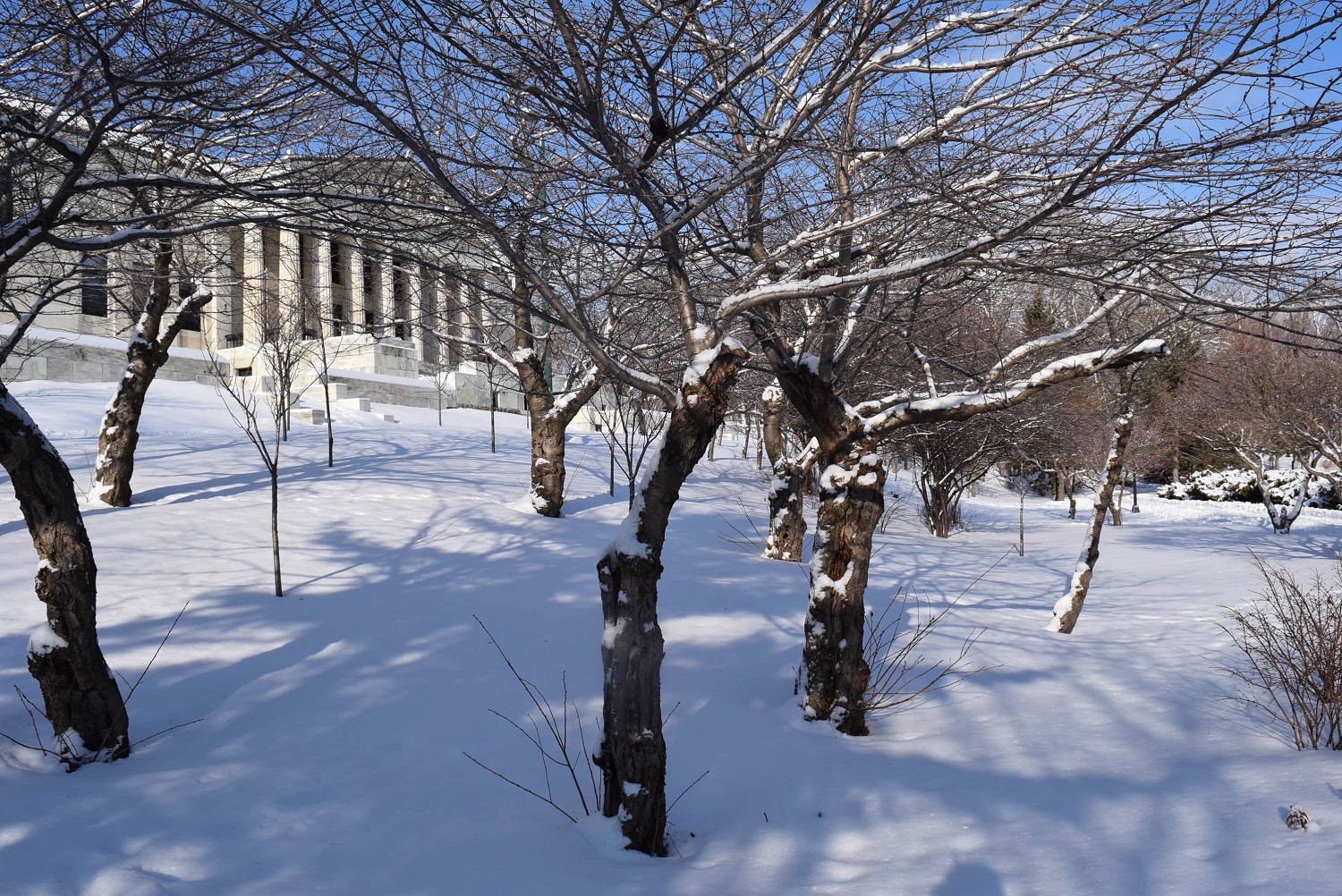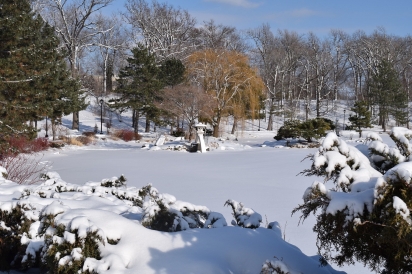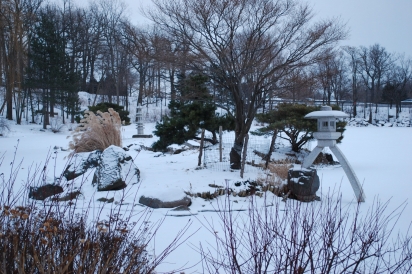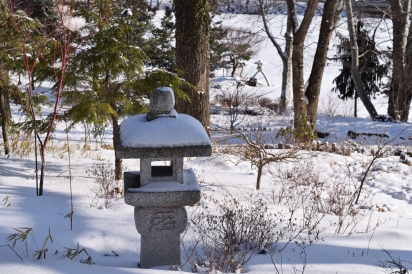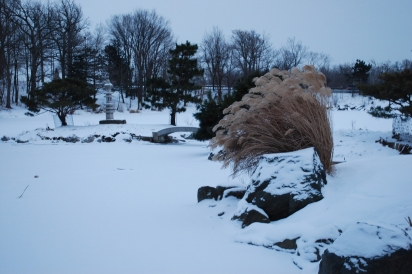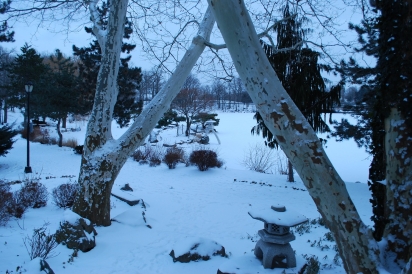Japanese Gardens: Winter Landscapes for Mind, Body and Soul
“Be like the sun and meadow, which are not in the least concerned about the coming winter.” ~ George Bernard Shaw
The northeastern region of the country is known for its remarkable seasons, each with distinctive characteristics and color palettes. Mother Nature cultivates a message of change using the environment as her medium, and it’s always impressive. But winter, especially in Western New York, is often overlooked when it comes to admiring gardens and the intrinsic splendor and peace they bestow.
Seeing winter through the lens of a Japanese garden will open your mind to this visually underrated season. Comfortable solitude invites an appreciation of minimalism when the temperatures drop and snow drifts across the landscape.
Conventional gardens are generally designed to highlight spring and summer while Japanese gardens are intended to be enjoyed year-round, as inspirational, albeit esoteric, collaborators with winter. The stark, monochromatic palette from an austere landscape punctuated by bare branches is a captivating environment for contemplation and finding inner balance.
Japanese gardens have elegant compositional devices including a symbiosis with nature, abstract compositional harmonies, shekkei (using borrowed scenery as part of the design), hide-and-reveal compositional techniques, rock artistry and focus on the ground-plane patterns and textures. Understanding and maximizing the visual effect of seasonal colors that vary throughout the year is also important—from lush greens in spring and summer, to a striking collage of colors in fall, to minimalist hues of white and grey in winter.
Several elements are incorporated for both utilitarian function and as conduits for translations of ancient symbolism. Water is used because it represents renewal, calm and continuity in the future. Clear circulating water also contributes to keeping the air fresh throughout the summer. Ponds and cascades are aligned with respect to the sun to determine how it (and the moon) will be reflected by the water.
Stone is given special attention in Eastern philosophy, symbolizing the duration and omnipresence of the forces of nature. Stones anchor the garden to the ground. Depending on their size and shape, stones are laid out to create hills and valleys that give life to cascades, streams and ponds. Comprehending the beauty of a Japanese garden means understanding the beauty of stones—not quarried stones, but those shaped and sculpted by nature alone. Until you can ardently feel that stones have character, tones and values, the whole artistic meaning of a Japanese garden cannot be revealed.
With the advent of the tea ceremony, the lantern became a leading element in the layout of a Japanese garden. Originally intended to guide visitors during nocturnal celebrations, its light was also considered as the light of knowledge clearing away the clouds of ignorance. Sculpted in stone, a lantern placed near water provides an architectural element which contrasts with the natural components of the garden.
Bridges are sites for lingering, taking in the beauty of the landscape and enjoying the softness of the breeze. Built of wood, bamboo, earth or stone, bridges can be rounded, arc-shaped or in zigzags, but they always remain in harmony with surrounding nature.
Plants are associated with moving thoughts and universal forms of life. The care given to plants in a Japanese garden is like that given to bonsai trees: Living plants are shaped to the exact form needed for the desired symbolic or graphic effect. Variation in plant texture, size, color and flowers is embraced rather than forced to conform.
To see one of these tranquil gardens in person you don’t have to travel far. Residing within an Olmsted landscape, a Japanese garden is tucked behind the Buffalo History Museum. In 1962 Buffalo connected with Kanazawa, Japan through an international Sister City initiative. In 1971 interest in a Japanese garden was taking shape and the horticultural gesture to Kanazawa was completed in 1974. A major renovation of the garden, including new trees, shrubs, paths and stone lanterns, was sponsored by Kanazawa in 1996. Positioned next to Mirror Lake, the garden has matured gracefully over the years.
NATURE FOR HEALTH AND WELL-BEING
Japanese gardens are found in at least 53 countries, and North America has more than 250. Their role in community health and well-being can be profound, according to the North American Japanese Garden Design Association, which held its biennial conference in early 2017. Most of the presentations touched on the emerging science and design analysis of Japanese gardens and their relationship with wellness.
Shinrin-yoku, Japanese for forest-bathing, highlights the restorative properties of being in a forest and surrounded by nature. Developed by the Japanese Ministry of Agriculture in 1982 as a reaction to increasing mortality rates caused by extreme overworking, Shinrin-yoku refers to the process of soaking up the sights, sounds and smells of a natural setting to promote physiological and psychological health.
Spending time in the Japanese Garden of Buffalo may be a terrific way to find refuge from a modern world inundated with technology and a digital landscape that changes with lightning speed.
ELEMENTS OF JAPANESE GARDENS AT HOME
Designing a Japanese garden may be daunting, but welcoming a few calming alternatives into your home may have you wishing for winter each year.
Indoor water features seem to ebb and flow in popularity, but now would be a good time to buy one. Think about the stones in the fountain and the symbolism of duration. The fountain of water cascading over the stones recreates a sense of movement and keeps the air fresh, even if on a smaller scale.
Decluttering your interior space can be calming and introduce you to your surroundings from a new perspective. Regarding flowers, for instance, would you enjoy a few curled branches with interesting texture in a vase compared to a large traditional arrangement?
A current trend in floral arrangements aligns with Japanese horticultural design because of its focus on using only seasonally available flowers and foliage. Florists are realizing that locally foraged materials are sustainable and healthier, and embody the idea of appreciating beauty in all plants. The approach is a nod to simpler times, with minimalism rather than overabundance as its foundation. The style also echoes seasonal changes and the temporal quality of life found in Japanese gardens.
ELEMENTS OF JAPANESE GARDENS OUTSIDE
If you’re ready for the challenge of designing a Japanese garden but don’t have the patience to wait for it to mature over the next few decades, consider winter-blooming plants and shrubs, which you could view from within your home.
Chinese Witch Hazel (Hamamelis mollis): fragrant bright yellow flowers with thin curly petals that appear even when branches are bare
Fragrant Wintersweet (Chimonanthus praecox): fragrant shrub blooms with small yellow flowers as early as December and possibly through March
Japanese Apricot (Prunus mume): ornamental flowering tree with showy fragrant flowers
Jacqueline Postill (Daphne bholua): produces masses of intoxicatingly fragrant pink flowers from December to March
Winter Beauty (Comus sanguined): red stemmed dogwood
Japanese Garden of Buffalo: 1 Museum Ct, Buffalo, NY 14216; 716-873-9644


